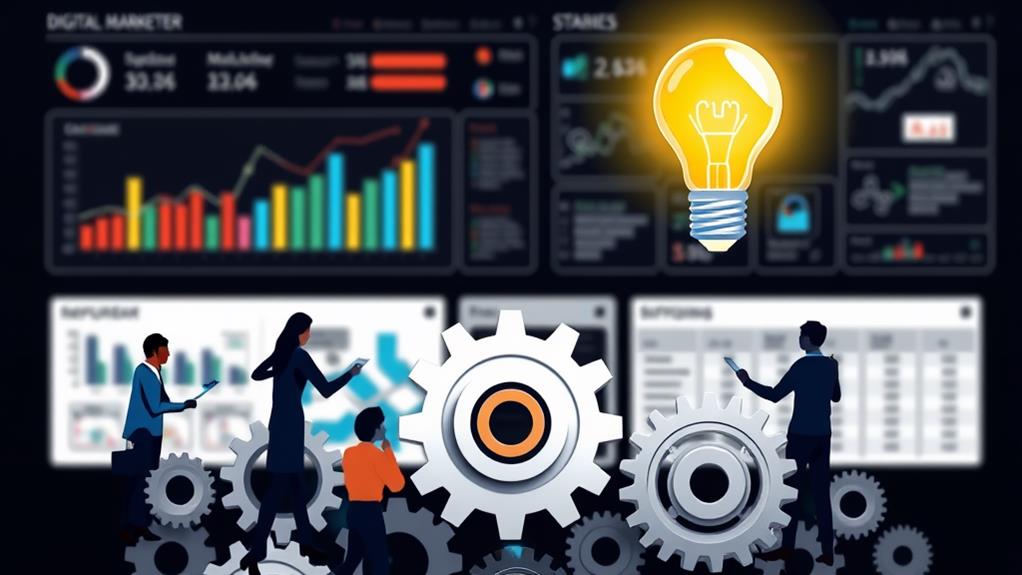Handling the hurdles of marketing automation integration may seem intimidating, but with clear goals, you’ll steer your team in the right direction! Establishing SMART goals (that’s Specific, Measurable, Achievable, Relevant, and Time-bound goals) not only gives focus but aligns with broader business objectives seamlessly. Secure robust IT support early on and maintain a dance of collaboration to tackle slow processing and data centralization issues. Don’t forget to personalize your messaging—it’s like the secret sauce to boosting engagement. Manage your budget wisely and keep an eye on ROI. And hey, if you’re keen to master even more strategies and tips, keep going!
Table of Contents
Key Takeaways
- Identify clear, SMART goals to align marketing automation efforts with business objectives.
- Secure robust IT support for seamless tool integration and ongoing collaboration.
- Centralize data to enhance accuracy, consistency, and decision-making capabilities.
- Manage financial investments by evaluating ROI and starting with low-cost solutions.
- Leverage AI for real-time insights, predictive analytics, and optimized workflows.
Identifying Clear Goals

In the domain of marketing automation, identifying clear goals is paramount, as it establishes a focused direction for all subsequent actions. It’s like setting a GPS for your marketing strategy—without it, you’re just driving aimlessly.
To truly harness the power of marketing automation efforts and aim for a stellar return on investment (ROI), defining SMART goals (Specific, Measurable, Achievable, Relevant, Time-bound) is non-negotiable. These goals help pinpoint specific pain points, guaranteeing your automation workflows aren’t just busy work, but effective marketing automation tools that propel your business forward.
Imagine launching a spaceship without coordinates; chaos, right? Similarly, a structured plan outlining desired outcomes guarantees your marketing automation aligns seamlessly with broader business objectives.
And let’s not forget the importance of continuous monitoring. By keeping an eye on established goals, you can make data-driven adjustments to keep your automation workflows relevant to ever-changing customer needs and market trends.
Lastly, researching and selecting software that aligns with these identified goals can streamline the implementation process. This guarantees your marketing automation efforts not only meet but exceed expectations.
Securing IT Support
Securing robust IT support is critical to the seamless implementation and optimization of marketing automation tools. Without the technical expertise of your IT team, integrating these tools with existing systems can become a labyrinthine challenge. Involving IT teams early in the process doesn’t just streamline integration—it guarantees that the customization aligns perfectly with your organizational needs. Think of it as setting a solid foundation before building a skyscraper.
But it’s not just about bringing them in early; ongoing collaboration between marketing and IT is key. Regular communication helps identify specific pain points that marketing automation can address, creating a strategic approach to tool selection and implementation. Imagine the synergy when both departments work hand in hand—magic happens!
Formal training for marketing teams on the technical aspects of these tools can’t be overlooked. It’s like teaching a chef how to use the latest kitchen gadget; without training, even the best tools are underutilized.
Addressing Slow Processing

While robust IT support lays the groundwork for effective marketing automation, another important hurdle is addressing slow processing times. Slow processing can occur when automation tools operate outside core systems, leading to delayed responses and actions in customer interactions.
These delays can throw a wrench into real-time functionality, impacting the overall efficiency of marketing campaigns. Understanding the specific capabilities of your automation tools is vital. Setting realistic expectations regarding their processing speed and integration with other systems can help in mitigating slowdowns.
Often, customer interactions trigger events across disparate systems, creating bottlenecks that can disrupt the customer experience. Regular monitoring and optimizing the integration of various automation tools is essential for enhancing workflow efficiency.
Identifying and addressing bottlenecks guarantees smoother operations and quicker response times. This ongoing vigilance not only improves processing speeds but also greatly enhances the customer experience by providing timely and relevant interactions.
In a world where real-time functionality is king, eliminating slow processing is key to maintaining a competitive edge. By strategically optimizing your tools and workflows, you can transform potential obstacles into opportunities for innovation and growth.
Centralizing Data
Centralizing data is a cornerstone of effective marketing automation, as it greatly enhances the accuracy and consistency of customer information. Imagine a world where your customer data platforms seamlessly consolidate information from various sources into one central database. This unified view of customer interactions not only improves data accuracy but also streamlines workflows, making data more accessible for analysis and reporting. The result? Superior decision-making and more effective marketing automation efforts.
Now, let’s talk integration. By ensuring all relevant systems are tied into a central database, you eliminate the chaos of scattered data. This integrated systems approach supports smoother marketing automation efforts, leading to higher campaign performance.
Plus, regular data cleansing and normalization processes are essential to maintaining the integrity of this centralized data. Say goodbye to duplicates and errors, and hello to pristine data purity.
Ultimately, centralizing data is not just about grouping information; it’s about creating a powerhouse of accurate, actionable insights. When customer interactions are tracked and analyzed from a single source, you’re equipped to make smarter, faster decisions.
Embrace this innovative approach, and watch your marketing workflow and decision-making soar to new heights.
Managing Financial Investment

Maneuvering the financial investment required for marketing automation is a critical aspect that organizations must meticulously manage.
Let’s face it, marketing automation tools can be pricey. With upfront licensing fees, ongoing maintenance, and training expenses, the costs can add up faster than you can say “ROI.” But fear not, savvy innovators! By carefully evaluating the return on investment (ROI), you can guarantee that the benefits—like increased sales and improved efficiency—justify the implementation costs.
Budgeting for these tools means accounting for both direct and indirect expenses. Think beyond the price tag; consider potential disruptions during the implementation phase and ongoing support requirements.
To mitigate financial risks, it’s wise to start small. Low-cost automation solutions can provide a solid starting point, allowing for gradual investment as your business grows.
Regularly monitoring key performance indicators (KPIs) is your secret weapon in justifying financial investment. Track metrics like conversion rates and customer engagement improvements to guarantee your marketing automation strategies are hitting the mark.
Personalizing Messaging
Personalizing messaging within marketing automation is a game-changer for enhancing customer engagement and driving conversion rates. With personalization, you can tailor your messages to align with individual customer behaviors and preferences, skyrocketing engagement rates by up to 50%. It’s like having a conversation with each customer, making them feel seen and valued.
Why Personalization Matters:
- Advanced Segmentation: Automation tools allow you to create highly targeted messages based on customer interests. Imagine sending a book recommendation to an avid reader—instant connection, right? This boosts conversion rates considerably.
- Dynamic Content: Incorporating dynamic content into your campaigns can increase click-through rates by 20%. When customers receive relevant information, they’re more likely to engage. It’s like magic, but it’s really just smart marketing.
- Data-Driven Insights: Use insights gleaned from customer interactions to inform your personalization strategies. It’s like having a crystal ball that tells you what your audience wants, helping you foster long-term loyalty.
- A/B Testing: Implement A/B testing to refine your approach. Test different messages and see what resonates. It’s the scientific method for marketers, and it works.
With these strategies, lead nurturing becomes a breeze, and you’ll watch your conversion rates soar.
Enhancing Communication Platforms

Efficient communication platforms are pivotal for the seamless execution of marketing automation strategies. Imagine trying to run a marathon with tangled shoelaces; that’s what your marketing automation looks like without robust communication platforms.
Enter Communication Platforms as a Service (CPaaS). These have revolutionized the way marketing and sales teams collaborate, ensuring that workflows are as smooth as a well-oiled machine.
By leveraging APIs for seamless integration, various communication tools can now talk to each other effortlessly. This enables real-time messaging and collaboration, which are game-changers for operational efficiency.
Automated campaigns thrive on this cohesive interaction, ensuring that customer engagement is not just maintained but elevated.
Integrating multiple channels like email, chat, and social media makes customer interactions consistent and engaging. Real-time messaging tools speed up response times, cutting through the sluggishness often seen in marketing automation systems.
The strategic use of CPaaS doesn’t just trim communication costs; it also supercharges customer engagement, making it a win-win for all.
In a nutshell, enhancing communication platforms isn’t just a good idea—it’s a necessity for any organization serious about optimizing their marketing automation efforts.
Implementing Data Management
Building on the foundation of robust communication platforms, the next step to mastering marketing automation is implementing effective data management strategies. Centralizing customer data in a single repository enhances data accuracy and consistency, making it simpler to manage and analyze information for your marketing campaigns.
Trust us, nothing kills a campaign faster than bad data.
Here’s a clear path to follow:
- Data Cleansing and Normalization: Regularly clean and normalize your data to eliminate duplicates and errors. This guarantees your marketing campaigns target the right audience with reliable information, making your efforts more effective.
- Data Validation Tools: Implementing data validation tools helps verify the accuracy of contact information. This reduces the likelihood of ineffective communications, improving the overall performance of your campaigns. Because nobody likes talking to a ghost email.
- APIs and Connectors: Seamless data sharing between systems is essential. Use APIs and connectors to integrate systems, creating a unified view of your customer data. Better integration means better targeting.
- Data Privacy Compliance: Confirm compliance with data privacy regulations like GDPR and CCPA. This protects sensitive customer data and builds trust with your consumers.
Remember, a trusted customer is a loyal customer.
These strategies will supercharge your marketing automation efforts, setting the stage for innovative, data-driven success.
Leveraging Enterprise AI

Imagine supercharging your marketing efforts with the incredible power of AI.
By enhancing AI capabilities and integrating them seamlessly into your marketing automation platforms, you can access real-time insights, super-speed data processing, and hyper-targeted campaigns.
This means not only will you keep up with the fast-paced market, but you’ll be several steps ahead, dazzling your customers with personalized experiences that feel almost magical.
Enhancing AI Capabilities
Leveraging enterprise AI represents a powerful advancement in marketing automation, transforming how businesses analyze and utilize data. The integration of AI-driven tools allows companies to explore deeply into customer behaviors, creating personalized content that resonates on an individual level.
Enhanced data analysis facilitates the segmentation process, enabling marketers to craft campaigns that are not just targeted but laser-focused on real-time insights and interactions.
To truly grasp the transformative power of AI in marketing, consider these core enhancements:
- Predictive Analytics: By accurately identifying customer behaviors and preferences, AI helps forecast future actions and tailor strategies accordingly. This foresight is akin to having a crystal ball for your marketing efforts.
- Automated Segmentation: AI-driven tools streamline the segmentation process, ensuring that each campaign hits the mark with its intended audience, maximizing engagement and minimizing wasted efforts.
- Personalized Content Creation: Generative AI technologies empower marketers to produce personalized content at scale, turning generic messages into compelling narratives that boost customer engagement.
- Optimized Workflows: AI algorithms analyze performance metrics and suggest strategic adjustments, refining marketing workflows and enhancing overall campaign ROI.
Integrating AI Seamlessly
While enhancing AI capabilities has proven to be revolutionary in marketing automation, the next step is guaranteeing these AI tools are seamlessly integrated into existing systems. This integration is key to revealing the full potential of AI, allowing businesses to elevate their marketing strategies through data-driven decision-making and real-time insights.
By leveraging enterprise AI, companies can vastly improve personalization capabilities. Imagine delivering content that feels tailor-made for each customer—now that’s a game-changer! Predictive analytics can forecast customer behavior, optimizing campaigns before they even launch.
And who doesn’t love operational efficiency? AI can streamline processes, automating data analysis to save time and resources.
Let’s not forget chatbots, the unsung heroes of customer engagement. Implementing AI-driven chatbots within your marketing automation systems can slash response times, providing instant assistance to customers and keeping them happy.
Continuous innovation in AI technology guarantees that your marketing automation remains adaptable to evolving business needs, helping you stay competitive in the market.
Overcoming ERP Challenges
Implementing an ERP system often presents a myriad of challenges that can hinder its successful adoption and utilization within an organization. Tackling these hurdles head-on is vital for seamless integration, particularly when leveraging marketing automation technology.
Here’s how to overcome common obstacles:
- Data Integration Issues: With 60% of organizations encountering data migration difficulties, it’s important to invest in robust automation tools that offer efficient data integration capabilities. This guarantees a smoother changeover and reduces delays and costs.
- User Resistance: Nearly 70% of employees resist ERP changes due to fear of the unknown or inadequate training. Address this by setting clear objectives and offering thorough training and support. Engaged and well-informed users are more likely to embrace new systems.
- Integration with Existing Systems: About 50% of ERP projects fail due to compatibility issues with legacy systems. Define a clear project scope that includes extensive compatibility checks and phased implementation to mitigate these risks.
- Lack of Clear Objectives: Undefined goals lead to a 40% increase in project overruns. Establish clear, measurable objectives from the outset to steer the project towards success, ensuring efficient system utilization.
Frequently Asked Questions
What Is the Biggest Obstacle to Marketing Automation?
The biggest obstacle to marketing automation is inadequate planning, which often leads to data silos, user adoption issues, system compatibility challenges, misaligned processes, poor content quality, budget constraints, insufficient training, flawed vendor selection, scalability issues, and extended integration timelines.
What Are the 4 Pillars of Marketing Automation?
The four pillars of marketing automation are strategy, technology, people, and processes. These pillars facilitate lead scoring, customer segmentation, email workflows, data synchronization, campaign management, performance analytics, user engagement, personalization strategies, CRM integration, and ROI measurement.
How Do You Succeed in Marketing Automation?
To succeed in marketing automation, focus on personalization strategies, workflow optimization, and robust data management. Prioritize customer segmentation, lead nurturing, and performance metrics. Guarantee careful software selection, address integration challenges, guarantee platform scalability, and provide thorough user training.
What Problem Does Marketing Automation Solve?
Marketing automation solves the problem of managing repetitive tasks by facilitating lead nurturing, customer segmentation, campaign optimization, and data synchronization. It enhances user engagement, delivers personalized messaging, aligns sales, and provides analytics insights, resulting in performance tracking and cost efficiency.
Conclusion
In summary, successfully integrating marketing automation involves clear goal-setting, robust IT support, efficient data centralization, and proper financial management. Addressing slow processing times, enhancing communication platforms, and leveraging enterprise AI are essential steps. Implementing effective data management and overcoming ERP challenges further guarantee seamless integration. By tackling these obstacles head-on, organizations can optimize their marketing efforts, leading to increased efficiency and better results. The journey may be challenging, but the rewards are certainly worth the effort.






